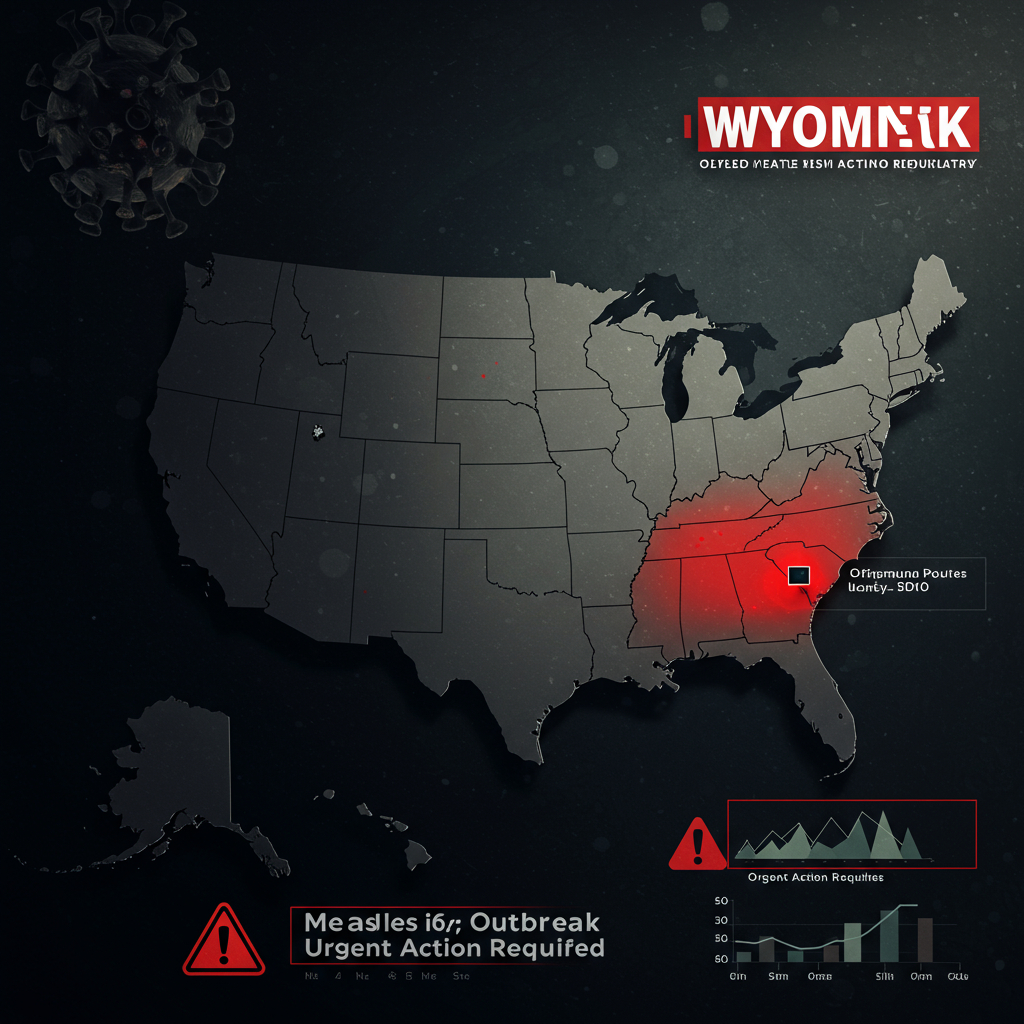wyoming has confirmed its first case of measles in 15 years, a development that underscores a significant and concerning national trend. This isolated case in the sparsely populated state is part of a broader surge. Across the United States, measles infections are now nearing their highest levels in almost 30 years. Public health officials are urging vigilance as highly contagious measles continues to spread.
Wyoming’s Unexpected Return of Measles
The Wyoming Department of Health (WDH) recently announced the confirmation of a measles case. It was identified in an unvaccinated child residing in Natrona County. This area lies in central Wyoming and includes the city of Casper.
State health officials noted this pediatric case marks the first time measles has been reported in Wyoming since 2010. The nearly two-decade gap highlights how rare the disease had become in the state. Details about how the child contracted the illness remain unclear. Officials did not release further identifying information like age or sex.
Potential Exposure Locations and Health Warnings
Health authorities have pinpointed specific periods and locations where the child was infectious. These were in the emergency department waiting room at Banner Wyoming Medical Center in Casper. Potential exposures occurred on Thursday, June 24, from 11 a.m. to 1 p.m. MT. Additional potential exposure happened on Friday, June 25, from 12:55 p.m. to 2:55 p.m. MT.
The WDH is working closely with Banner Wyoming Medical Center. Their goal is to notify individuals who may have been present during these times. This proactive step helps identify those at risk. Dr. Alexia Harrist, Wyoming’s state health officer, issued a warning. She advised potentially exposed individuals to monitor for measles symptoms for 21 days after exposure. Dr. Harrist also recommended considering avoidance of crowded public places. This includes high-risk settings such as daycare centers.
A National Resurgence: Cases Approach 30-Year Peak
Wyoming is not alone in reporting recent measles cases. It is the 37th state to confirm an infection this year. This reflects a worrying picture across the country. Data from the Centers for CDC indicates the US is experiencing a substantial increase.
As of a recent Wednesday, a total of roughly 1,267 measles cases have been confirmed nationwide. This trajectory places the United States on track to exceed the 1,274 cases seen in 2019. It is expected to reach the highest case count since 1992. This resurgence challenges the disease’s elimination status, which the US achieved in 2000.
Why Measles Cases Are Surging
Several factors contribute to this alarming rise in preventable infections. A significant driver is the nationwide decline in childhood vaccination rates. CDC data shows measles vaccination coverage among kindergarteners has dropped. It fell from 95.2% in the 2019-2020 school year to 92.7% in the 2023-2024 school year. Experts emphasize that community vaccination rates need to exceed 95% to achieve herd immunity. This collective protection shields those unable to be vaccinated.
An increase in parents seeking religious or personal conscience exemptions for required vaccinations also plays a role. Furthermore, outbreaks are frequently linked to unvaccinated Americans. These individuals contract measles abroad and return home, introducing the virus. International travel has been responsible for introducing measles into the US more than twice as often compared to the previous year.
Understanding the Threat: Measles Symptoms and Serious Complications
Measles is notoriously contagious. It is a respiratory virus that can remain airborne for up to two hours after an infected person leaves an area. Initial symptoms typically include a high fever, runny nose, cough, and red, watery eyes. These are followed a few days later by a characteristic rash. The rash usually starts on the face and spreads downward.
While most people recover, measles can cause serious and potentially deadly complications. These include pneumonia, blindness, and brain swelling (encephalitis). Brain swelling can lead to cognitive issues or deafness. The CDC reports about 1 in 5 unvaccinated individuals who contract measles require hospitalization. More tragically, roughly 1 in 1,000 children with measles may develop brain swelling leading to permanent damage. Up to 3 in 1,000 infected children may die from complications. This year alone, the US has seen three confirmed measles-related deaths. Two were unvaccinated children in Texas. Another was an unvaccinated adult in New Mexico.
Major Outbreak Areas Across the US
While Wyoming’s case is notable locally, several states are grappling with much larger outbreaks. According to recent reports, Texas leads the nation with over 750 cases across numerous counties. A significant portion of these cases is concentrated in Gaines County, affecting an undervaccinated community. Other states reporting substantial case numbers include New Mexico, Kansas, North Dakota, and Montana. These outbreaks highlight how quickly measles can spread in communities with lower vaccination coverage.
Prevention is Key: The Power of the MMR Vaccine
Fortunately, measles is highly preventable through vaccination. The measles, mumps, and rubella (MMR) vaccine is considered highly safe and effective. It provides robust, long-lasting protection against the disease. The standard vaccination schedule recommends two doses for children. The first dose is typically given between 12 and 15 months of age. The second dose is administered between ages 4 and 6 years. This two-dose series is about 97% effective in preventing measles infection.
Achieving high vaccination rates, ideally above the 95% threshold, is crucial for herd immunity. This protects infants too young for vaccination and individuals with weakened immune systems. It is important to note that scientific consensus overwhelmingly refutes any link between the MMR vaccine and autism, a claim based on a widely discredited study. In Wyoming, vaccination rates among kindergartners are relatively high. As of 2023 data, at least 93% statewide had received at least one MMR dose. In Natrona County, where the recent case occurred, this rate was slightly higher at 96%. While these rates are encouraging, even small pockets of unvaccinated individuals allow this highly contagious virus to take hold and spread.
Public Health Efforts and Recommendations
Public health officials universally recommend vaccination as the best defense against measles. The WDH echoed this, strongly advising all Wyoming residents to ensure their MMR vaccinations are up to date. Adults uncertain of their immunity may need additional doses. Those born before 1957 or with documented measles illness are generally considered immune. Staying informed and vaccinated protects not only individuals but the broader community, especially vulnerable populations.
Frequently Asked Questions
What are the main symptoms of measles and why is it so dangerous?
Measles typically starts with a high fever, cough, runny nose, and red, watery eyes. A characteristic rash appears later, spreading from the head down. It’s dangerous because it’s extremely contagious, easily spreading through the air. Complications can be severe, including pneumonia, brain swelling, blindness, and even death. Roughly 1 in 5 unvaccinated people with measles need hospitalization, and up to 3 in 1,000 children infected may die.
Where was the potential exposure in Wyoming, and what should exposed individuals do?
In Wyoming, potential exposure occurred in the emergency department waiting room at Banner Wyoming Medical Center in Casper. The specific times were Thursday, June 24 (11 a.m. – 1 p.m. MT) and Friday, June 25 (12:55 p.m. – 2:55 p.m. MT). If you were there during these times, health officials advise you to self-monitor for measles symptoms for 21 days. Consider avoiding crowded public spaces or high-risk settings like daycare centers during this period.
How effective is the MMR vaccine, and who is recommended to get it?
The MMR vaccine is highly effective at preventing measles. After two doses, it provides about 97% protection. Health authorities recommend children receive the first dose between 12-15 months and the second between 4-6 years. Adults should ensure they are up-to-date, especially if unsure of their immunity, unless they were born before 1957 or have documented immunity from past infection. Vaccination is the most effective way to prevent measles and protect communities.
The confirmation of a measles case in Wyoming serves as a stark reminder. Despite previous elimination, this highly contagious disease remains a threat. The case is part of a concerning national trend of rising infections. Ensuring high vaccination rates is paramount. Public health vigilance, coupled with individual responsibility through vaccination, is crucial to preventing wider outbreaks and protecting the most vulnerable members of society.



